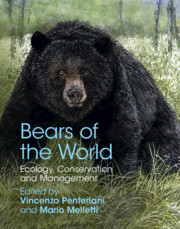Book contents
- Bears of the World
- Bears of the World
- Copyright page
- Dedication
- Frontispiece
- Contents
- Contributors
- Foreword
- Acknowledgments
- Introduction
- Part I Systematics, Ecology, and Behavior
- Chapter 1 Systematics, Evolution, and Genetics of Bears
- Chapter 2 Mating Strategies
- Chapter 3 Interspecific Interactions between Brown Bears, Ungulates, and Other Large Carnivores
- Chapter 4 Adaptations and Competitive Interactions of Tropical Asian Bear Species Define Their Biogeography: Past, Present, and Future
- Chapter 5 Remarkable Adaptations of the American Black Bear Help Explain Why it is the Most Common Bear: A Long-Term Study from the Center of its Range
- Part II Species Accounts
- Part III Human–Bear Coexistence
- Part IV Conservation and ManagementConservation and Management
- Index
- Miscellaneous Endmatter
- Plate Section (PDF Only)
- References
Chapter 4 - Adaptations and Competitive Interactions of Tropical Asian Bear Species Define Their Biogeography: Past, Present, and Future
from Part I - Systematics, Ecology, and Behavior
Published online by Cambridge University Press: 16 November 2020
- Bears of the World
- Bears of the World
- Copyright page
- Dedication
- Frontispiece
- Contents
- Contributors
- Foreword
- Acknowledgments
- Introduction
- Part I Systematics, Ecology, and Behavior
- Chapter 1 Systematics, Evolution, and Genetics of Bears
- Chapter 2 Mating Strategies
- Chapter 3 Interspecific Interactions between Brown Bears, Ungulates, and Other Large Carnivores
- Chapter 4 Adaptations and Competitive Interactions of Tropical Asian Bear Species Define Their Biogeography: Past, Present, and Future
- Chapter 5 Remarkable Adaptations of the American Black Bear Help Explain Why it is the Most Common Bear: A Long-Term Study from the Center of its Range
- Part II Species Accounts
- Part III Human–Bear Coexistence
- Part IV Conservation and ManagementConservation and Management
- Index
- Miscellaneous Endmatter
- Plate Section (PDF Only)
- References
Summary
Three potentially competing bear species inhabit tropical Asia: the sloth bear (Melursus ursinus), sun bear (Helarctos malayanus), and Asiatic black bear (Ursus thibetanus). Sun bears (30–80 kg), the smallest species of bear in the world, are about half the size of black bears (65–150 kg) and sloth bears (55–145 kg). What factors generate the separation of sloth bears geographically from black and sun bears? What factors facilitate the extensive sympatry of black bears and sun bears? How are these patterns structured by evolutionary history and competition between bear species, and what mechanisms facilitate their coexistence or maintain their separation? Has current forest loss and degradation benefited one species over another? If so, has interspecific competition played a part? These questions are the focus of this chapter.
- Type
- Chapter
- Information
- Bears of the WorldEcology, Conservation and Management, pp. 45 - 52Publisher: Cambridge University PressPrint publication year: 2020
References
- 1
- Cited by

